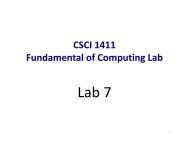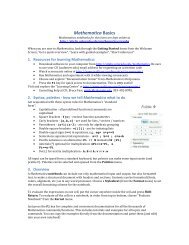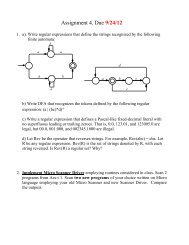[PDF] The Thickness and Chromatic Number of r - Gammeter.com
[PDF] The Thickness and Chromatic Number of r - Gammeter.com
[PDF] The Thickness and Chromatic Number of r - Gammeter.com
Create successful ePaper yourself
Turn your PDF publications into a flip-book with our unique Google optimized e-Paper software.
emain. We study a particular problem posed by Gerhard Ringel in 1959 [Rin59]<br />
(see also [Hut93]) that is a natural generalization <strong>of</strong> the Four Color <strong>The</strong>orem, namely<br />
What is the largest chromatic number <strong>of</strong> any thickness-t graph?<br />
<strong>The</strong> thickness <strong>of</strong> a graph is one possible measurement <strong>of</strong> “closeness to planarity”<br />
[HR03]. In particular, a graph G is said to have thickness t, written Θ(G) = t, if the<br />
edges <strong>of</strong> G can be partitioned into t sets each <strong>of</strong> which induces a planar graph, <strong>and</strong><br />
t is smallest possible. Ringel’s question has been answered definitively only in the<br />
case when t = 1, which is, <strong>of</strong> course, due to the <strong>The</strong> Four Color <strong>The</strong>orem. Let ft be<br />
the largest chromatic number <strong>of</strong> any thickness-t graph. <strong>The</strong> most general statement<br />
that can be made is [JT95]:<br />
⎧<br />
⎪⎨ {4}, if t = 1<br />
ft ∈ {9, 10, 11, 12} if t = 2 . (1)<br />
⎪⎩<br />
{6t − 2, 6t − 1, 6t} if t > 2<br />
<strong>The</strong> Sulanke graph (due to Thom Sulanke, reported in [Gar80]) was the only 9critical<br />
thickness-two graph that was known from 1973-2008. In [BGS08], the Sulanke<br />
graph was used to construct an infinite family <strong>of</strong> 9-critical thickness-two graphs <strong>and</strong><br />
hence for t = 2 any improvement in (1) will be asymptotic. <strong>The</strong> same technique can<br />
be easily adapted to show that if one k-critical thickness-t graph exists, then there<br />
are infinitely many such graphs. Thus any improvement to (1) for any value <strong>of</strong> t will<br />
be asymptotic as well.<br />
In [BGS08], the second <strong>and</strong> third authors studied a particular family <strong>of</strong> Catlin’s<br />
graphs. <strong>The</strong> historical motivation for these graphs was to disprove a conjecture <strong>of</strong><br />
Hajós that an s-chromatic graph necessarily contains a subdivision <strong>of</strong> Ks. Catlin’s<br />
graphs can be described in a variety <strong>of</strong> ways, one <strong>of</strong> which is as the lexicographic<br />
product <strong>of</strong> cycle Cn with the <strong>com</strong>plete graph Kr; another is as the r-inflation [PST03]<br />
<strong>of</strong> Cn.<br />
In this article we exp<strong>and</strong> on the idea <strong>of</strong> Catlin’s graphs by considering the 2inflation<br />
<strong>and</strong> then the r-inflations <strong>of</strong> a variety <strong>of</strong> graphs. We write G[Kr] or G[r] to<br />
indicate the r-inflation <strong>of</strong> graph G. We begin investigations <strong>of</strong> both the thickness<br />
<strong>and</strong> chromatic numbers <strong>of</strong> graphs inflated in this way. In this first article, the major<br />
emphasis is on the thickness with some naturally following results on chromatic<br />
number. In a subsequent article, the emphasis will be on the chromatic number <strong>of</strong><br />
r-inflated graphs.<br />
2


![[PDF] The Thickness and Chromatic Number of r - Gammeter.com](https://img.yumpu.com/3978766/2/500x640/pdf-the-thickness-and-chromatic-number-of-r-gammetercom.jpg)





